mont blanc circuit self guided
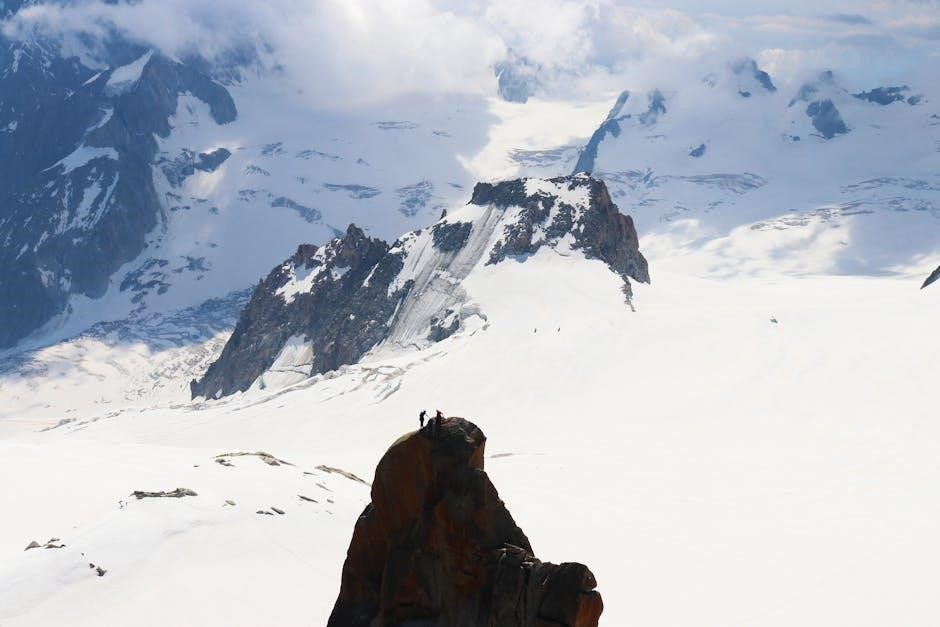
The Mont Blanc Circuit is a 103-mile alpine hike through France‚ Switzerland‚ and Italy‚ offering breathtaking mountain vistas․ A self-guided tour allows hikers to explore at their own pace‚ immersed in nature and culture‚ making it a popular choice for outdoor enthusiasts seeking adventure and freedom․
Overview of the Mont Blanc Circuit
The Mont Blanc Circuit‚ or Tour du Mont Blanc‚ is a renowned 103-mile alpine trek circling the Mont Blanc massif․ It spans across France‚ Switzerland‚ and Italy‚ offering breathtaking mountain vistas․ The trail features challenging terrain with over 34‚000 feet of elevation gain‚ making it a test of endurance․ Hikers traverse diverse landscapes‚ from lush valleys to high-altitude passes‚ while enjoying iconic views of Europe’s highest peak․ This circuit is a must-do for experienced hikers seeking adventure and immersion in nature‚ with options for self-guided exploration․
Benefits of a Self-Guided Tour
A self-guided Mont Blanc Circuit tour offers flexibility and independence‚ allowing hikers to set their own pace and itinerary․ This approach suits experienced trekkers who prefer autonomy‚ enabling them to connect deeply with nature and culture․ Without a fixed group schedule‚ hikers can explore hidden gems‚ enjoy peaceful moments‚ and savor local cuisine․ Self-guided tours also often include detailed maps and resources‚ ensuring a smooth journey while maintaining the freedom to adapt plans as desired‚ making it an ideal choice for those seeking adventure on their terms․
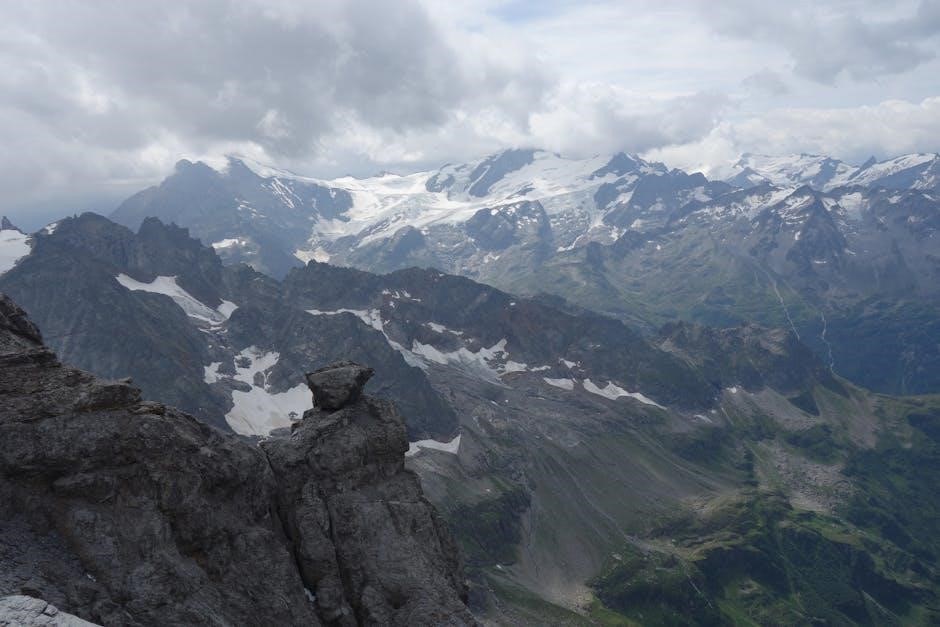
Planning and Preparing for the Mont Blanc Circuit
Thorough research‚ physical conditioning‚ and logistics planning are essential for a smooth Mont Blanc Circuit experience․ Prepare by booking refuges‚ understanding the route‚ and gathering necessary gear․
Understanding the Route and Itinerary
The Mont Blanc Circuit spans 103 miles with 34‚717 feet of elevation gain‚ typically completed in 11 days; It traverses France‚ Switzerland‚ and Italy‚ offering stunning alpine views․ The itinerary includes five major passes and diverse landscapes․ While the standard route is well-marked‚ flexibility exists for shorter options‚ such as completing key stages in five days․ Planning the route involves defining the start point and pacing according to fitness levels․ Detailed maps and guides are essential for navigating this iconic trail effectively․
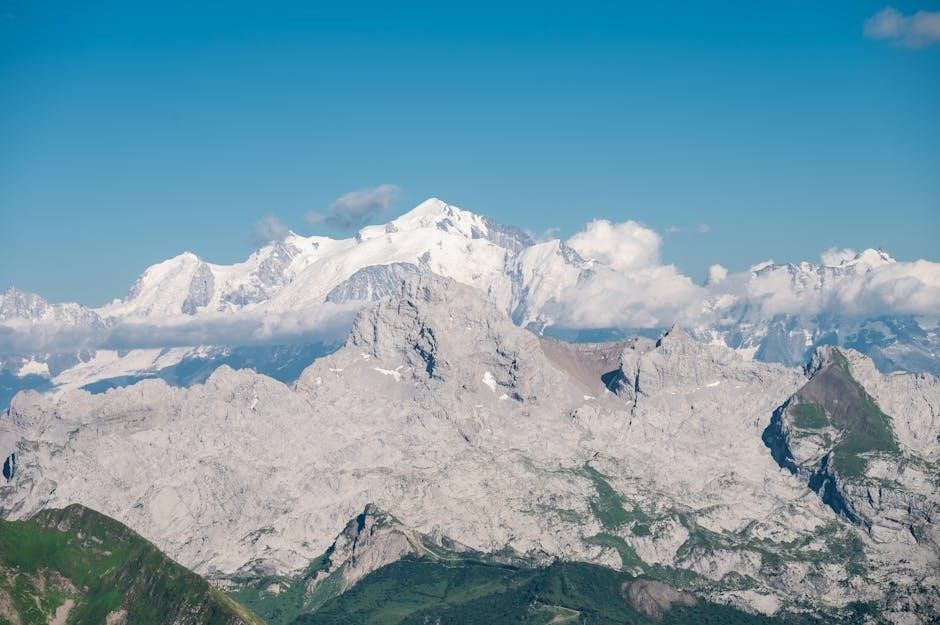
Choosing the Right Time to Hike
The best time to hike the Mont Blanc Circuit is mid-June to mid-September‚ when weather conditions are stable and trails are clear․ July and August are peak months‚ offering long days but larger crowds․ For a quieter experience‚ consider June or September‚ with cooler temperatures and fewer hikers․ Always check weather forecasts and trail openings before starting‚ as conditions can vary․ Proper planning ensures a safer and more enjoyable journey through this stunning alpine landscape․
Gathering Essential Information
Gathering essential information is crucial for a successful self-guided Mont Blanc Circuit tour․ Research the route‚ trail conditions‚ and weather forecasts to ensure preparedness․ Obtain detailed maps and guides‚ highlighting key landmarks and potential hazards․ Familiarize yourself with local regulations and environmental guidelines to preserve the alpine ecosystem․ Additionally‚ learn basic French phrases to communicate with locals‚ enhancing your cultural experience․ Accessible resources and community forums offer valuable insights from experienced hikers‚ helping you make informed decisions and avoid common pitfalls during your journey․
Booking Accommodations in Advance
Booking accommodations in advance is vital for the Mont Blanc Circuit‚ especially during peak season․ Consider staying in refuges or gîtes for a rustic experience‚ or opt for hotels in nearby villages for added comfort․ These can often be booked through local tourism websites or platforms like Booking․com․ Ensure your accommodations are close to trailheads to minimize travel time․ Additionally‚ confirm your bookings well in advance‚ as availability fills up quickly‚ especially in popular areas like Chamonix and Courmayeur‚ offering convenient access to trailheads and local amenities․
Physical Preparation and Training
Physical preparation is crucial for the Mont Blanc Circuit‚ as the hike involves 103 miles of challenging terrain with significant elevation gain․ Start training several months in advance with regular cardio exercises like running or cycling to build endurance․ Incorporate strength training to enhance stability and muscle endurance‚ focusing on lower body and core exercises․ Practice hiking with a loaded backpack to simulate trail conditions․ Gradually increase your mileage and intensity to adapt to the demands of the trek‚ ensuring you’re well-prepared for the strenuous mountain terrain․
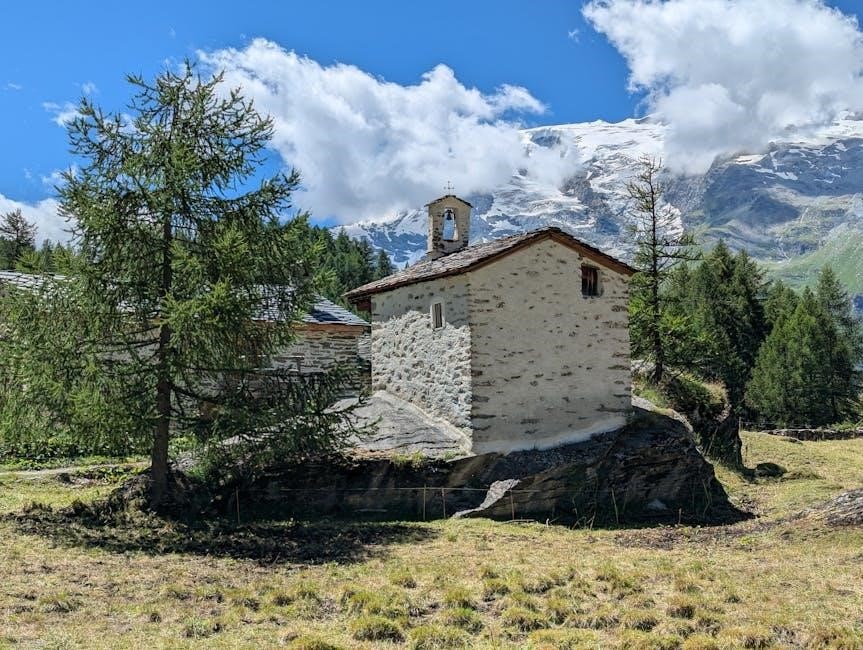
Navigation and Safety on the Mont Blanc Circuit
Navigation and safety are critical on the Mont Blanc Circuit; Use detailed maps‚ GPS devices‚ and trail markings to stay on track․ Carry emergency supplies and know local protocols for unforeseen situations‚ ensuring a secure and well-prepared journey through the challenging alpine terrain․
Trail Markings and Signage
The Mont Blanc Circuit is well-marked with clear signs and trail indicators‚ ensuring hikers can navigate confidently․ White and red painted markings‚ along with directional signs‚ guide hikers through diverse terrain․ Consistent signage at junctions and key points helps maintain direction‚ while local maps and GPS apps provide additional support․ While the trail is well-marked‚ carrying a detailed map or GPS device is recommended‚ especially for less experienced hikers‚ to enhance safety and navigation efficiency throughout the journey․
Essential Navigation Tools and Apps
For the Mont Blanc Circuit‚ essential navigation tools include GPS devices‚ detailed maps‚ and reliable apps like Komoot or Maps․me․ These apps offer downloadable maps for offline use‚ route tracking‚ and real-time updates․ GPS devices provide precise location data‚ while paper maps serve as backups․ Many hikers also use digital tools like Guthook Guides for trail-specific information․ Combining these tools ensures accurate navigation‚ especially in remote areas with limited connectivity․ Always carry extra batteries and ensure devices are fully charged before starting each day․
Understanding GPS and Maps for the Route
GPS devices and detailed maps are crucial for navigating the Mont Blanc Circuit․ Use a GPS with pre-loaded routes or apps like ViewRanger for real-time tracking․ Carry a paper map‚ such as the IGN 1:25‚000 scale for France‚ as a backup․ Topographic maps reveal elevations‚ trails‚ and landmarks‚ while GPS provides precise coordinates․ Ensure your device has extra batteries‚ as remote areas may lack power sources․ Always cross-reference GPS data with physical maps to stay oriented and avoid navigation errors during the hike․
Safety Protocols and Emergency Procedures
Carry a first-aid kit‚ emergency shelter‚ and a portable phone charger․ Inform someone of your itinerary and expected return time․ Familiarize yourself with local emergency numbers‚ such as 112 in Europe; GPS apps like ViewRanger can send distress signals if needed․ Stay aware of weather changes and know basic mountain first aid․ Always carry a map and whistle for signaling․ In case of an emergency‚ remain calm and seek visible landmarks or trails to locate help․ Preparedness is key to safely navigating the Mont Blanc Circuit․
Weather Conditions and Risk Management
The Mont Blanc Circuit is known for unpredictable mountain weather‚ with frequent snow‚ ice‚ and potential storms․ Always check local forecasts before starting each day․ Carry waterproof clothing‚ crampons‚ and an ice axe if necessary․ Be prepared for rapid changes in conditions‚ which can increase the risk of avalanches or slippery terrain․ Monitor trail signs and avoid risky paths during adverse weather․ Stay informed through local guides or apps like ViewRanger to ensure safe navigation and minimize exposure to harsh conditions․
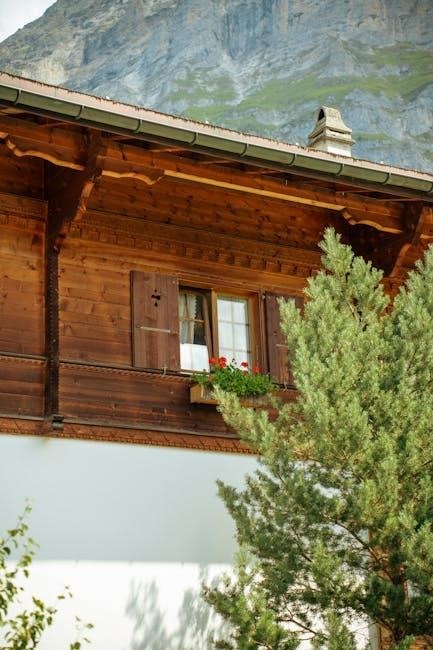
Accommodation and Logistics
The Mont Blanc Circuit offers various accommodations‚ including refuges‚ gîtes‚ and hotels․ Booking in advance is essential‚ especially during peak season․ Logistics for stays and meals can be efficiently managed through self-guided packages that provide detailed itineraries and planning support․
Refuges and Gîtes: What to Expect
Refuges and gîtes along the Mont Blanc Circuit provide basic yet comfortable accommodations for hikers․ Expect shared dormitories‚ communal dining areas‚ and simple meals․ These mountain lodges offer a cozy atmosphere‚ often serving local cuisine․ Booking in advance is crucial‚ especially during peak season․ Refuges and gîtes are ideal for self-guided hikers‚ providing logistical support and a welcoming space to rest after a day on the trail․
Hotels and Lodges Along the Route
Hotels and lodges on the Mont Blanc Circuit offer a higher level of comfort and amenities compared to refuges and gîtes․ Located in charming mountain villages‚ they provide private rooms‚ en-suite facilities‚ and diverse dining options․ Many lodges cater specifically to hikers‚ offering services like packed lunches‚ laundry‚ and Wi-Fi․ Booking in advance is essential‚ especially during peak season‚ to secure a spot in these popular accommodations․ They are ideal for self-guided hikers seeking a mix of comfort and convenience during their trek․
Logistics for Booking and Confirming Stays
Booking accommodations along the Mont Blanc Circuit requires careful planning‚ especially during peak season․ Refuges and gîtes often fill up quickly‚ so securing reservations in advance is crucial․ Many hikers use online platforms or contact local tourist offices to book stays․ For self-guided trekkers‚ some tour operators offer logistical support‚ including luggage transfers and accommodation arrangements․ Ensure all bookings are confirmed before starting your hike‚ and carry printed or digital copies of your reservations․ Planning ahead guarantees a smooth and stress-free experience on the trail․
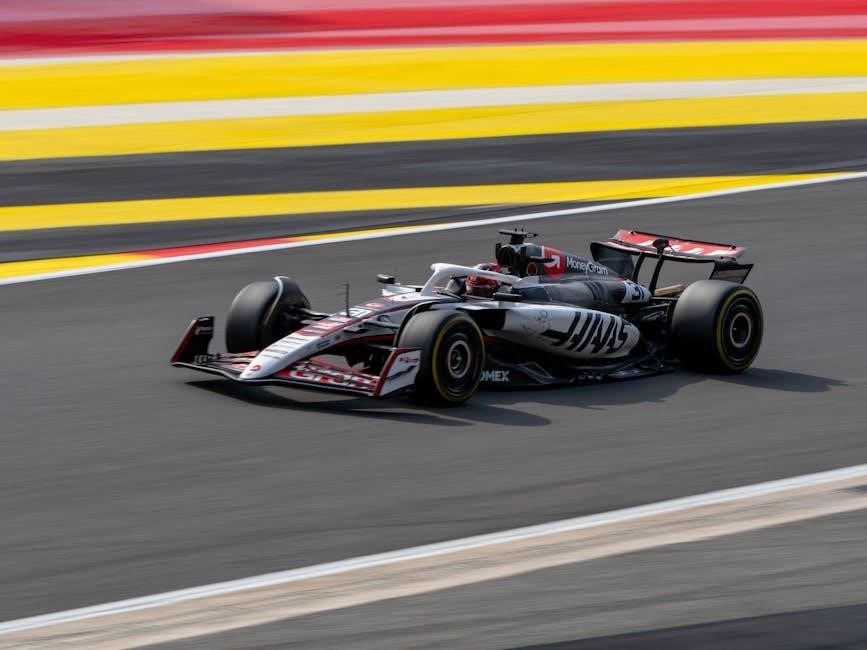
Packing and Gear for the Mont Blanc Circuit
Essentials include lightweight clothing‚ sturdy footwear‚ and a reliable backpack․ Avoid overpacking; good trail shoes and navigation tools are must-haves for this iconic alpine trek․
Essential Items to Bring Along
For the Mont Blanc Circuit‚ pack lightweight‚ durable gear․ Include sturdy hiking boots‚ moisture-wicking layers‚ a waterproof jacket‚ and a comfortable backpack․ Trekking poles‚ a first-aid kit‚ and a headlamp are must-haves․ Carry a map‚ GPS device‚ and extra batteries․ Bring a reusable water bottle or hydration bladder‚ snacks‚ and sunscreen․ Lightweight‚ quick-drying clothing and warm layers for cold mornings and evenings are crucial․ Always check the weather forecast before departure to ensure you’re prepared for changing conditions․ Pack strategically to avoid unnecessary weight while ensuring safety and comfort throughout your journey․
Choosing the Right Clothing and Footwear
Selecting the right clothing and footwear is crucial for the Mont Blanc Circuit․ Opt for lightweight‚ breathable‚ and moisture-wicking layers to manage varying mountain conditions․ A waterproof jacket and pants are essential for unpredictable weather․ Choose sturdy trail shoes or hiking boots with excellent grip and ankle support․ Consider merino wool socks for comfort and blister prevention․ Include warm layers like a fleece or down jacket for cooler mornings and evenings․ Ensure your clothing is versatile and durable to withstand the demands of the trail while keeping you comfortable throughout your journey․
Backpack and Gear Recommendations
A lightweight‚ comfortable backpack (30-40 liters) is ideal for the Mont Blanc Circuit․ Look for waterproof or water-resistant material to protect your gear․ Include essentials like a first-aid kit‚ headlamp‚ extra batteries‚ and a reusable water bottle or hydration bladder․ Trekking poles can aid balance on uneven terrain․ Pack lightweight‚ compact clothing and toiletries․ Ensure your gear is well-organized for easy access; Avoid overloading—every pound counts on long hikes․ Choose durable‚ high-quality items to withstand the rigors of the trail while keeping your load manageable and efficient․
Lightweight and Efficient Packing Tips
To ensure a comfortable and efficient hike‚ prioritize lightweight and multi-use items․ Roll clothing to save space and reduce wrinkles‚ and use compression bags for bulky items like jackets․ Pack only essentials and avoid duplicates․ Choose lightweight alternatives‚ such as quick-drying clothing and a compact first-aid kit․ Organize gear into categories (e․g․‚ clothing‚ toiletries‚ electronics) for easy access; Consider a packing list to avoid overpacking․ Remember‚ every ounce saved reduces fatigue on the trail‚ allowing you to enjoy the journey more freely․
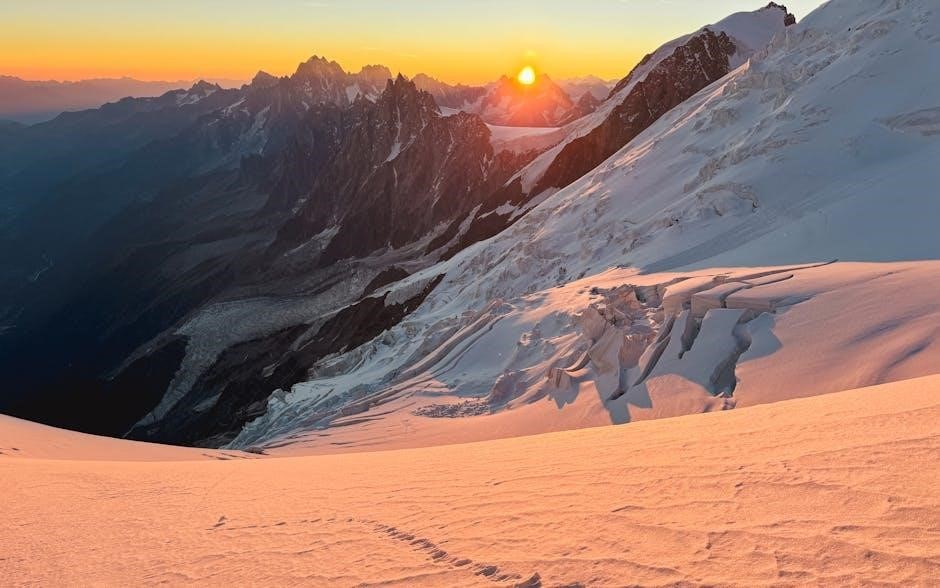
Cost Estimation and Budgeting
Budgeting for the Mont Blanc Circuit includes costs for accommodations‚ meals‚ transportation‚ and gear․ Plan for €60-€100 per day‚ depending on lodging choices and meal preferences․
Overall Budget for the Tour
The Mont Blanc Circuit self-guided tour typically requires a budget of €800-€1‚200 per person for the standard 7-11 day itinerary․ This includes €30-€50 per night for refuges‚ €15-€25 for meals‚ and transportation costs like €20-€50 for transfers․ Equipment and gear can add another €100-€200‚ depending on what you already own․ Additionally‚ optional expenses like luggage transfers (€20-€30 per stage) or guidebooks (€10-€20) should be considered․ Planning ahead and booking accommodations early can help reduce costs․
Cost of Accommodation and Meals
Accommodation costs on the Mont Blanc Circuit range from €30-€50 per night for refuges and gîtes‚ which are basic but comfortable․ Hotels and lodges offer more luxury at €80-€120 per night․ Meals in refuges typically cost €15-€25 for dinner and €10-€15 for breakfast․ Budget an additional €10-€15 daily for snacks and drinks․ Self-catering options in some villages can reduce meal expenses․ Booking in advance is crucial‚ especially during peak season․
Transportation Costs to and from the Trail
Transportation costs vary depending on your starting point․ Train tickets from Geneva to Chamonix cost around €10-€20․ Bus fares between villages are €2-€5․ Airport transfers can range from €40-€100‚ while renting a car for the trip may cost €200-€400․ Budgeting €100-€200 for transportation is recommended‚ depending on your arrival location․ Public transit is affordable and convenient‚ but renting a car offers flexibility for pre- or post-hike exploration․ Plan ahead to secure the best rates and schedules․
Equipment and Gear Expenses
Equipment and gear expenses for the Mont Blanc Circuit can range from €200 to €500‚ depending on what you already own․ A sturdy backpack costs €50-€150‚ while hiking poles are €50-€100․ Navigation tools like a GPS device or app may cost €100-€200․ Trekking poles‚ waterproof jackets‚ and insulated layers are essential․ Footwear is a major investment‚ with high-quality hiking boots costing €150-€300․ Optional gear like a portable stove or camping equipment adds to the cost․ Budget accordingly to ensure you have durable‚ reliable gear for the hike․
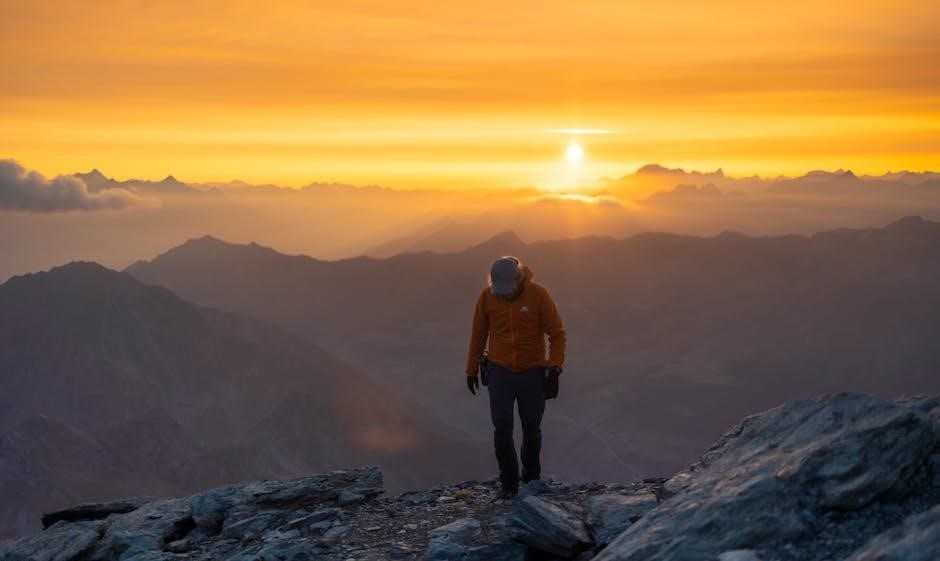
Physical Conditioning and Health
Physical conditioning is crucial for the Mont Blanc Circuit‚ requiring strong stamina‚ endurance‚ and strength for mountain terrain․ Self-guided tours allow pacing to suit fitness levels․
Building Stamina for the Hike
Building stamina is essential for the Mont Blanc Circuit‚ as the 103-mile trail with 34‚717 feet of ascent demands consistent energy levels․ Start training 6-9 months in advance with aerobic exercises like cycling‚ swimming‚ or running․ Incorporate hiking-specific workouts‚ such as carrying a loaded backpack on shorter trails․ Gradually increase weekly mileage and include elevation gain to simulate mountain conditions․ Rest and recovery are equally important to avoid injury․ A well-structured plan ensures you’ll be prepared for the challenges ahead‚ making your self-guided trek more enjoyable․
Strength Training for Mountain Terrain
Strength training is crucial for tackling the Mont Blanc Circuit’s demanding mountain terrain․ Focus on exercises like squats‚ lunges‚ and step-ups to build leg strength․ Incorporate core workouts‚ such as planks and Russian twists‚ to improve stability․ Use resistance bands or weighted backpacks to simulate hiking with a load․ Strengthening your upper body with push-ups and rows will also aid in navigating uneven paths․ Gradually increase intensity to avoid injury‚ ensuring you’re prepared for the trail’s challenging ascents and descents while maintaining flexibility for optimal mobility․
Endurance Exercises for Long-Distance Hiking
Building endurance is vital for the Mont Blanc Circuit․ Engage in activities like hiking shorter trails‚ brisk walking‚ or cycling to improve cardiovascular fitness․ Swimming and cross-country skiing are also excellent for enhancing stamina․ Incorporate interval training to simulate the uneven terrain and elevation changes․ Gradually increase the duration and intensity of workouts to adapt your body to long-distance efforts․ Consistency is key to developing the endurance needed for the demanding 103-mile trek‚ ensuring you can maintain a steady pace throughout the journey․
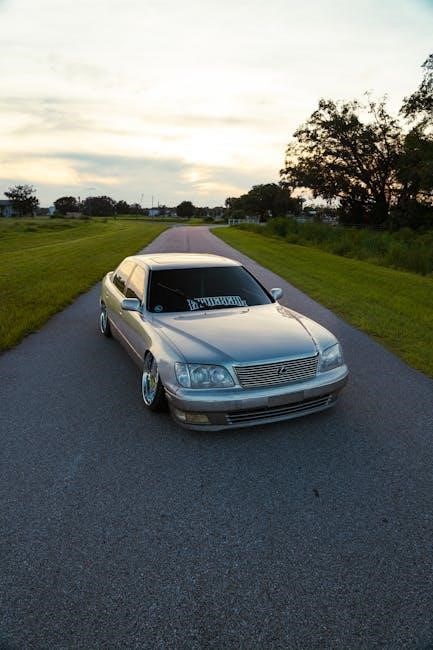
Cultural and Environmental Considerations
Experience the rich Alpine culture by savoring local cuisine and engaging with mountain communities․ Respect the fragile environment by minimizing waste and staying on designated trails to preserve biodiversity and scenic beauty․
Local Cuisine and Dining Experiences
Indulge in the rich flavors of Alpine cuisine during your Mont Blanc Circuit self-guided tour․ Enjoy hearty French dishes like tartiflette and raclette‚ Swiss specialties such as fondue and rösti‚ and Italian delights like polenta and risotto․ Refuges and mountain restaurants offer authentic meals‚ often sourced from local ingredients․ Don’t miss the opportunity to try regional wines and Genepi‚ a traditional Alpine liqueur․ Dining in these charming settings adds a cultural and culinary dimension to your hiking adventure‚ blending nature with local traditions and hospitality․
Interacting with Local Communities
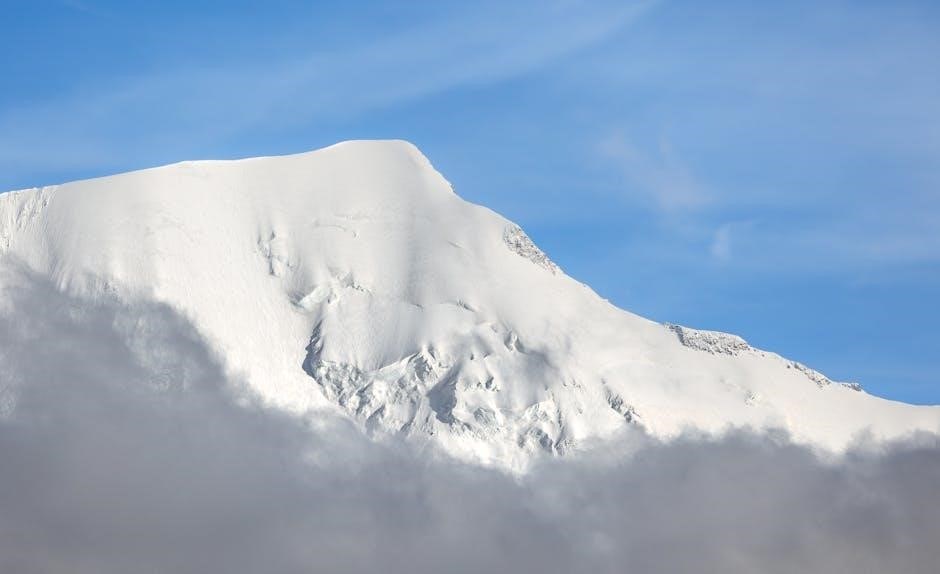
Engaging with local communities enhances your Mont Blanc Circuit experience; Stay in family-run refuges and gîtes‚ where hosts share stories and tips․ Enjoy shared meals‚ fostering camaraderie with fellow hikers and locals․ Learn a few basic French phrases to connect with residents‚ showing respect for their culture․ These interactions create lasting memories and deepen your appreciation of the region’s heritage‚ making your self-guided tour more enriching and personally rewarding․
Respecting the Alpine Environment
Respecting the Alpine environment is crucial while hiking the Mont Blanc Circuit․ Minimize waste by carrying reusable containers and disposing of trash properly․ Use biodegradable toiletries to protect water sources․ Stay on marked trails to avoid eroding sensitive habitats․ Refrain from picking wildflowers or disturbing wildlife․ Keep noise levels low to maintain tranquility for both nature and fellow hikers․ Bringing necessary gear to leave the trail in the same condition as you found it ensures the beauty of the Alps is preserved for future generations to enjoy․
Learning About the History of the Region
Exploring the history of the Mont Blanc region enriches your hiking experience․ The area is steeped in mountaineering heritage‚ with Mont Blanc first climbed in 1786․ The trail traverses territories with rich cultural ties between France‚ Switzerland‚ and Italy․ Historical landmarks like alpine villages and ancient trade routes highlight the region’s past․ Understanding the local history fosters a deeper connection with the landscapes and communities you encounter‚ making your self-guided tour a journey through time as much as through nature․
Embark on the Mont Blanc Circuit self-guided tour for an unforgettable journey through stunning alpine landscapes‚ rich cultures‚ and personal achievements․ Start planning your life-changing adventure today!
Final Tips for a Successful Self-Guided Tour
Plan meticulously‚ pack lightly‚ and stay flexible․ Research trail conditions and weather forecasts beforehand․ Carry a detailed map and GPS device․ Book accommodations early‚ especially during peak season․ Train physically to enhance stamina and strength․ Respect local environments and cultures; Stay informed about emergency protocols and carry essential safety gear․ Engage with local communities for enriching experiences․ Lastly‚ embrace the journey with an open mind and a sense of adventure for a truly rewarding experience on the Mont Blanc Circuit․